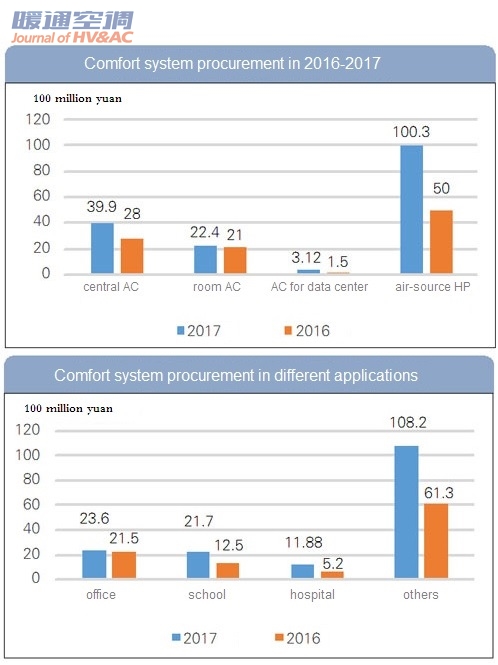热门
 Holmak: Heat exchanger made of PET
Holmak: Heat exchanger made of PET "China Water efficiency label management" implem…
"China Water efficiency label management" implem… Build Eco Xpo (BEX) Asia and Mostra Convegno Exp…
Build Eco Xpo (BEX) Asia and Mostra Convegno Exp… MOSTRA CONVEGNO EXPOCOMFORT (MCE) ASIA TO DEBUT…
MOSTRA CONVEGNO EXPOCOMFORT (MCE) ASIA TO DEBUT… CRAA published nameplate code of multi split air…
CRAA published nameplate code of multi split air… 2019 China AC market marked by slide domestic sa…
2019 China AC market marked by slide domestic sa… Global air conditioning systems market is expect…
Global air conditioning systems market is expect…
Procurement of air-source heat pump in 2017 broke 100 million yuan
China comfort system procurement projects increased to 5,000 in 2017, with 11 regions exceeding 100 million yuan. As "coal-to-electricity" expanded, more regions will reach 100 million yuan of procurement.

Procurement in North China accounted for 58%
In order to improve the air quality in North China, Ministry of Environment Protection of China released a policy to promote "coal-to-electricity" projects in North China. As statistics, comfort system procurement in North China accounted for 58%. Of them, comfort system procurement in Beijing increased over 200%, reaching 8000 million yuan in 2017, compared with previous year, following by Hebei and Shandong with over 800 million yuan and Guangdong, Fujian and Henan with over 600 million yuan.
The "coal-to-electricity" projects are expanding in Beijing, not only in rural areas but also agriculture.
Air-source heat pump procurement reached 100 million yuan in 2017
Driving by “coal-to-electricity” policy and high awareness of air-source heat pump, air-source heat pump will welcome a high speed development. Big projects are one of the major factors that push the air-source heat pump procurement increased 200% to 100 million yuan in 2017. Compared with 2016, central air conditioning systems increased 43% to 3,990 million yuan with office as a leader and followed by healthcare and education. Room air conditioning systems development was stable in 2017 to 2,240 million yuan.
Inverter AC supports clean heating
In 2017, many cities in Shangdong Province preferred inverter air conditioners due to their mature technology and cost efficiency, but which cannot be instead of air-source heat pump. Inverter air conditioner is one of new choices for clean heating in winter.
"Coal-to-electricity" procurement reached 10 billion yuan in 2017
Doubtless, "coal-to-electricity" procurement was the most active in 2017 and accounted of 60% of the total to break 10 billion yuan, followed by office, education and healthcare to 2.36 billion yuan, 2.17 billion yuan and 1.188 billon yuan, respectively.
下一篇:China air conditioning market slows down in 2018[ 03-12 ]




